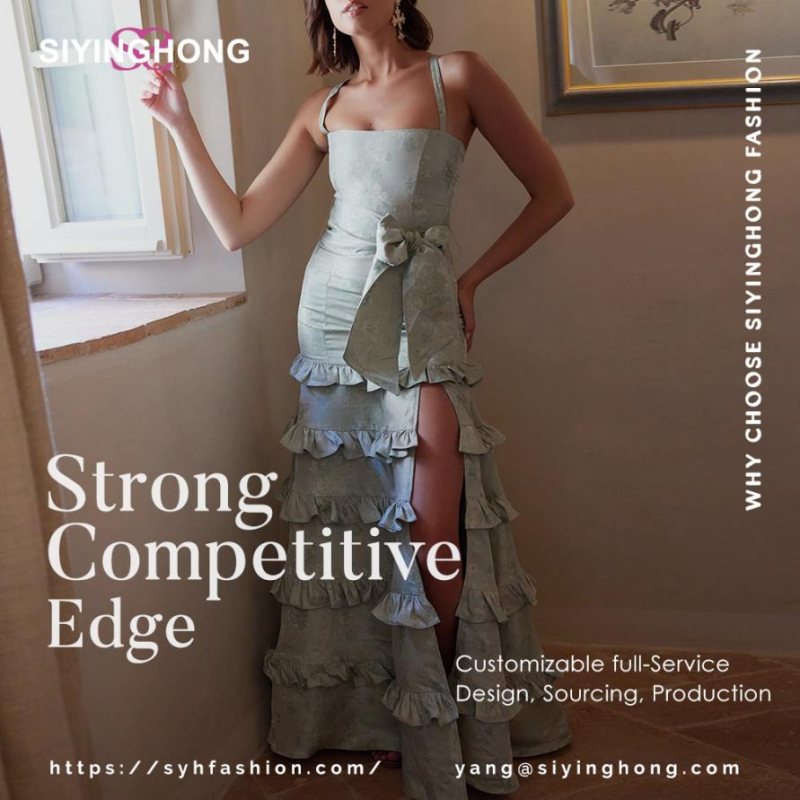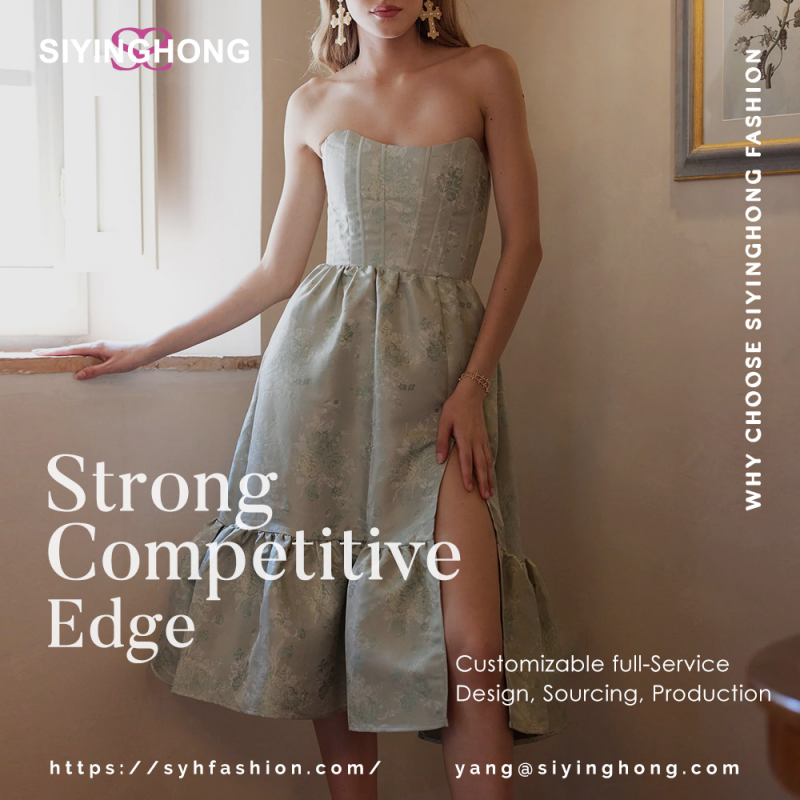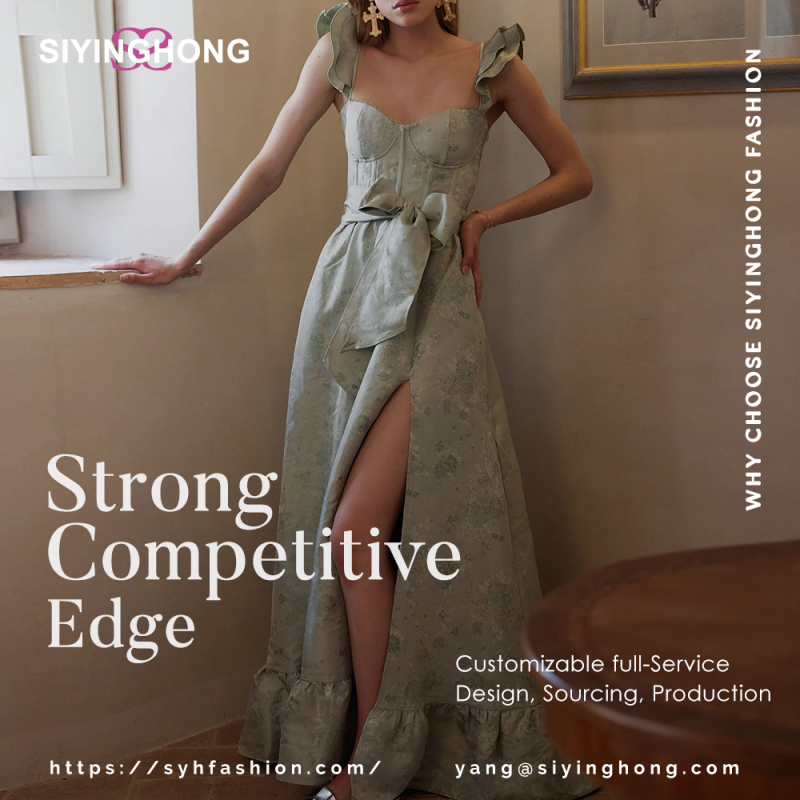The commonly used garment weaving fabric is the loom in the form of shuttle, in which the yarn is formed through the staggered of longitude and latitude. Its organization generally has three categories of flat, twill and satin, and their changing organization (in modern times, due to the application of shuttle-free loom, the weaving of such fabrics does not use the form of shuttle, but the fabric is still shuttle weaving). From the component of cotton fabric, silk fabric, wool fabric, linen fabric, chemical fiber fabric and their blended and woven fabrics, the use of woven fabrics in clothing whether in variety or in the lead of production quantity. Due to the differences in the style, technology, style and other factors, there are great differences in the processing process and process means. The following is the basic knowledge of general woven garment processing.

(1) Production process of woven clothing
Surface materials into the factory inspection technology, cutting and sewing keyhole button, ironing garment inspection packaging storage or shipment.
After the fabric enters the factory, the quantity count and the appearance and internal quality should be checked. Only when they meet the production requirements can they be put into operation. Before mass production, technical preparation should be carried out first, including the formulation of process sheet, sample plate and sample garment production. The sample garment can enter the next production process only after being confirmed by the customer. The fabrics are cut and sewn into semi-finished products. After some shuttle fabrics are made into semi-finished products, according to the special process requirements, they must be sorted and processed, such as garment washing, garment sand washing, twisting effect processing, etc., and finally, through the auxiliary process and finishing process, and then packaged and stored after passing the inspection.
(2) Purpose and requirements of fabric inspection
The quality of good fabrics is an important part of controlling the quality of finished products. The inspection and determination of the incoming fabric can effectively improve the quality rate of clothing.
Fabric inspection includes both appearance quality and internal quality. The main appearance of the fabric is whether there is damage, stains, weaving defects, color difference and so on. The sand washing fabric should also pay attention to whether there are sand road, dead fold seal, crack and other sand washing defects. The defects affecting the appearance should be marked with marks in the inspection and avoided when cutting.
The inner quality of the fabric mainly includes shrinkage, color fastness and weight (m, ounce) three content. During the inspection sampling, representative samples of different varieties and different colors should be cut for testing to ensure the accuracy of the data.
At the same time, the auxiliary materials entering the factory should also be inspected, such as the shrinkage rate of the elastic belt, the adhesion fastness of the adhesive lining, the degree of zipper smoothness, etc. The auxiliary materials that cannot meet the requirements will not be put into operation.
(3) The main workflow of technical preparation
Before mass production, the technical personnel should first do a good job of technical preparation before mass production. Technical preparation includes three contents: process sheet, paper sample making and sample garment making. Technical preparation is an important means to ensure the smooth mass production and the final product to meet customer requirements.
Process sheet is a guiding document in garment processing. It puts forward detailed requirements on the specifications, sewing, ironing, finishing and packaging, etc., and also clarifies the details such as the collocation of garment accessories and the density of sewing tracks, see Table 1-1. All processes in the garment processing should be carried out strictly according to the requirements of the process sheet.
Sample production requires accurate size and complete specifications. The contour lines of the relevant parts coincide accurately. The clothing number, part, specification, direction of silk locks and quality requirements should be marked on the sample, and the sample composite seal should be stamped on the relevant splicing place.
After the completion of the process sheet and sample formulation, the production of small batch sample clothes can be carried out, and the discrepancy can be corrected in time according to the requirements of customers and the process, and the process difficulties can be solved, so that the mass flow operation can be conducted smoothly. The sample has become one of the important inspection bases after the customer.

(4) Cutting process requirements
Before cutting, we should draw the discharging drawing according to the sample. “Complete, reasonable and saving” is the basic principle of discharging. Main process requirements in the cutting process are as follows:
(1) Clear the quantity at the towing time point, and pay attention to avoid the defects.
(2) For different batches of dyed or sand washed fabrics should be cut in batches to prevent the color difference phenomenon on the same clothing. For the existence of color difference in a fabric to the color difference discharge.
(3) When discharging materials, pay attention to whether the silk strands of the fabric and the direction of the garment strands meet the process requirements. For the velvet fabric (such as velvet, velvet, corduroy, etc.), the materials should not be discharged backwards, otherwise the depth of the clothing color will be affected.
(4) For the plaid fabric, we should pay attention to the alignment and positioning of the bars in each layer, so as to ensure the coherence and symmetry of the bars on the clothing.
(5) Cutting requires accurate cutting, and straight and smooth lines. The pavement should not be too thick, and the upper and lower layers of the fabric are not overcut.
(6) Cut the knife according to the sample mark.
(7) Attention should be taken not to affect the appearance of the garment when using the cone hole marking. After cutting, the quantity and tablet inspection should be counted, and bundled according to the clothing specifications, with the ticket endorsement number, parts and specifications attached.
(5) Sewing and sewing is the central process of garment processing. Garment sewing can be divided into machine sewing and manual sewing according to the style and craft style. In the sewing and processing process of the implementation of the flow of the operation.
The application of adhesive lining in clothing processing is more common, its role is to simplify the sewing process, make the clothing quality uniform, prevent deformation and wrinkle, and play a certain role in the clothing modeling. Its types of non-woven fabrics, woven fabrics, knitwear as the base cloth, the use of adhesive lining should be selected according to the clothing fabric and parts, and to accurately grasp the time, temperature and pressure, so as to achieve better results.
In the processing of woven clothing, the stitches are connected according to a certain law to form a firm and beautiful thread.
The trace can be summarized into the following four types:
1. Chain string trace The string string trace is made of one or two sutures. A single suture. Its advantage is that the amount of lines used in the unit length is small, but the disadvantage is that the edge lock release will occur when the chain line is broken. The thread of double suture is called double chain seam, which is made of a needle and hook line string, its elasticity and strength are better than the lock thread, and not easy to disperse at the same time. Single line chain line trace is often used in the jacket hem, trouser seam, suit jacket barge head, etc. Double-line chain line trace is often used in the suture of the seam edge, the back seam and side seam of the pants, the elastic belt and other parts with more stretch and strong force.
2. The lock line trace, also known as the shuttle suture trace, is interconnected by two sutures in the seam. The two ends of the suture have the same shape, and its stretching and elasticity are poor, but the upper and lower suture is close. The linear lock suture trace is the most common suture suture trace, which is often used for the suture of two pieces of suture material. Such as sewing edge, saving sewing, bagging and so on.
3. The wrap suture trace is a thread set at the edge of the seam by a series of sutures.According to the number of suture tracks (single suture seam, double suture seam… Six seam wrap seam). Its characteristic is to make the edge of the sewing material is wrapped, play the role of preventing the edge of the fabric. When the seam is stretched, there can be a certain degree of mutual transfer between the surface line and the bottom line, so the elasticity of the seam is better, so it is widely used in the edge of the fabric. Three-wire and four-wire seams are the most commonly used woven clothing. Five-wire and six-line seams, also known as “composite tracks”, are composed of a double-line seam with three-line or four-wire seams. Its biggest characteristic is the large strength, which can be combined and wrapped at the same time, so as to improve the density of sewing traces and the production efficiency of sewing.
4. The suture trace is made of more than two needles and a curved hook thread through each other, and sometimes one or two decorative threads are added to the front. The characteristics of the suture trace are strong, good tensile, smooth seam, in some occasions (such as stitching seam) can also play a role to prevent the edge of the fabric.
The form of basic stitching is shown in Figure 1-13. In addition to basic sewing, there are also processing methods such as folding and cloth embroidery according to the requirements of style and technology. The choice of needle, thread and needle track density in woven garment sewing should take into account the requirements of garment fabric texture and process.
Needles can be classified by “type and number”. According to the shape, stitches can be divided into S, J, B, U, Y type, corresponding to different fabrics, respectively using the appropriate needle type.
The thickness of the stitches used in China is distinguished by the number, and the degree of thickness becomes thicker and thicker with the increase of the number. The stitches used in garment processing generally range from 7 to 18, and different clothing fabrics use different stitches of different thickness.
In principle, the selection of stitches should be the same texture and color as the garment fabric (especially for decorative design). Sutures generally include silk thread, cotton thread, cotton / polyester thread, polyester thread, etc. When choosing stitches, we should also pay attention to the quality of stitches, such as color fastness, shrinkage, fastness strength and so on. Standard suture shall be used for all fabrics.
The needle track density is the density of the foot of the needle, which is judged by the number of sutures within 3cm on the surface of the cloth, and can also be expressed by the number of pinholes in the 3cm cloth. Standard needle trace density in woven garment processing.
The sewing of clothing on the whole requires neat and beautiful, can not appear asymmetry, crooked, leakage, wrong seam and other phenomena. In the sewing, we should pay attention to the pattern of the splicing, and the symmetry. The suture shall be uniform and straight, smooth and smooth; the tangent of clothing surface is flat without wrinkles and small folding; the suture is in good condition, without broken line, floating line, and important parts such as collar tip shall not be wired.

(6) keyhole nail buckle
Lock hole and nail buckle in clothing are usually made by machine. Eye buckle is divided into flat hole and eye hole according to its shape, commonly known as sleeping hole and pigeon eye hole.
Straight eyes are widely used in shirts, skirts, pants and other thin clothing material products.
Phoenix eyes are mostly used in jackets, suits and other thick fabrics on the coat category.
Lock hole should pay attention to the following points:
(1) Whether the cingulate position is correct.
(2) Whether the size of the button eye is matched with the size and thickness of the button.
(3) Whether the buttonhole opening is cut well.
(4) have a stretch (elastic) or very thin clothing material, to consider the use of the lock hole in the inner layer of cloth reinforcement. The sewing of the button should correspond to the position of the buttingpoint, otherwise the button will not cause the distortion and skew of the button position. Attention should also be paid to whether the amount and strength of the staple line are enough to prevent the button from falling off, and whether the number of buckle on the thick fabric clothing is sufficient.
(Seven) hot people often use “three points sewing seven points hot” to strong adjustment hot is an important process in clothing processing.
There are three main functions of the ironing:
(1) Remove the wrinkles of the clothes through spraying and ironing, and take the cracks flat.
(2) After hot shaping treatment, make the clothing appearance flat, pleated, straight lines.
(3) Use the “return” and “pull” ironing skills to appropriately change the shrinkage of the fiber and the density and direction of the fabric fabric organization, shape the three-dimensional shape of clothing, to adapt to the requirements of human body shape and activity state, so that the clothing to achieve the purpose of beautiful appearance and comfortable wearing.
The four basic elements that affect the fabric ironing are: temperature, humidity, pressure and time. The ironing temperature is the main factor affecting the ironing effect. Grasping the ironing temperature of various fabrics is the key problem of dressing. The ironing temperature is too low to reach the ironing effect; the ironing temperature will cause damage.
The ironing temperature of all kinds of fiber, even by contact time, moving speed, ironing pressure, whether bedding, bedding thickness and moisture have a variety of factors.
The following phenomena should be avoided in the ironing:
(1) Aurora and burning on the surface of the garment.
(2) The surface of the clothing left small ripples and wrinkles and other hot defects.
(3) There are leakage and hot parts.
(8) Garment inspection
The inspection of clothing should run through the whole processing process of cutting, sewing, keyhole buckle, finishing and ironing. Before the packaging and storage, the finished products should also be fully inspected to ensure the quality of the products.
The main contents of the finished product inspection include:
(1) Whether the style is the same as the confirmation sample.
(2) Whether the size and specifications meet the requirements of the process sheet and the sample clothing.
(3) Whether the suture is correct, and whether the sewing is neat and flat clothes.
(4) the clothing of the strip fabric check whether the pair is correct.
(5) whether the fabric silk wisp is correct, whether there are no defects on the fabric, oil exists.
(6) Whether there is a color difference problem in the same clothing.
(7) Whether the ironing is good.
(8) Whether the bonding lining is firm, and whether there is a glue infiltration phenomenon.
(9) Whether the wire head has been repaired.
(10) Whether the clothing accessories are complete.
(11) Whether the size mark, washing mark and trademark on the clothing are consistent with the actual goods content, and whether the position is correct.
(12) Whether the overall shape of the clothing is good.
(13) Whether the packaging meets the requirements.
(9) Packaging and storage
The packaging of clothing can be divided into two kinds of hanging and packing, which is generally divided into internal packaging and outer packaging.
Inner packaging refers to one or more pieces of clothing into a rubber bag. The payment number and size of the clothing should be consistent with those marked on the rubber bag, and the packaging should be smooth and beautiful. Some special styles of clothing should be packaged with special treatment, such as twisted clothing to be packaged in the form of wrung, to maintain its styling style.
The outer package is usually packed in cartons, according to customer requirements or process sheet instructions. Packaging form is generally a mixed color mixed code, single color independent code, single color mixed code, mixed color independent code four kinds. When packing, we should pay attention to the complete quantity and the accurate color and size collocation. Brush the box mark on the outer box, indicating the customer, the shipping port, the box number, the quantity, the origin, etc., and the content is consistent with the actual goods.
Post time: May-25-2024






